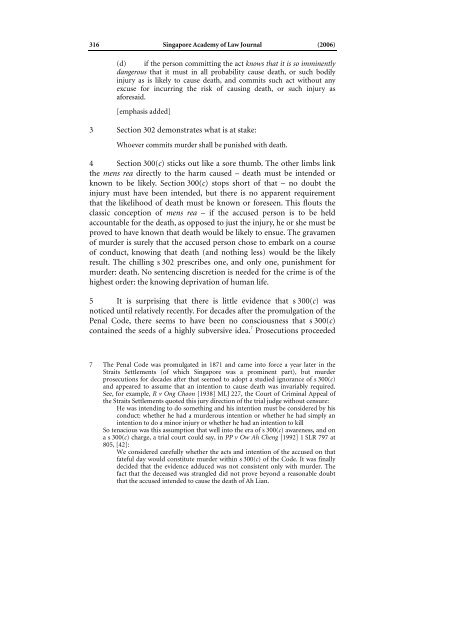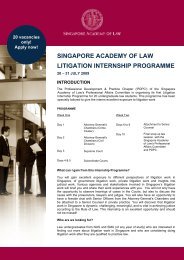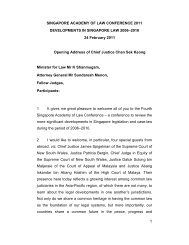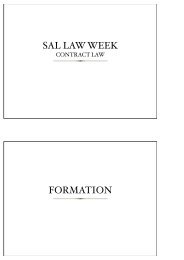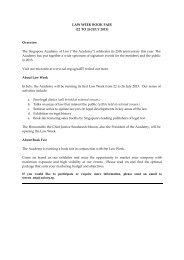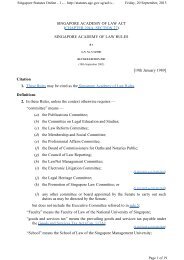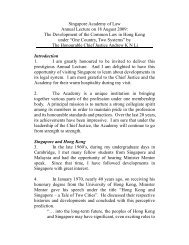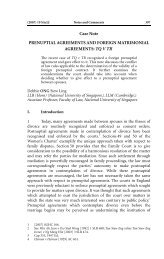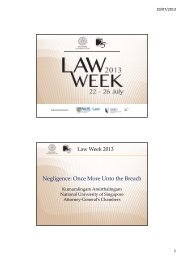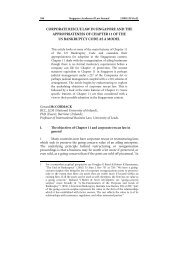2. Managing Mens Rea in Singapore - Singapore Academy of Law
2. Managing Mens Rea in Singapore - Singapore Academy of Law
2. Managing Mens Rea in Singapore - Singapore Academy of Law
Create successful ePaper yourself
Turn your PDF publications into a flip-book with our unique Google optimized e-Paper software.
316S<strong>in</strong>gapore <strong>Academy</strong> <strong>of</strong> <strong>Law</strong> Journal (2006)(d) if the person committ<strong>in</strong>g the act knows that it is so imm<strong>in</strong>entlydangerous that it must <strong>in</strong> all probability cause death, or such bodily<strong>in</strong>jury as is likely to cause death, and commits such act without anyexcuse for <strong>in</strong>curr<strong>in</strong>g the risk <strong>of</strong> caus<strong>in</strong>g death, or such <strong>in</strong>jury asaforesaid.[emphasis added]3 Section 302 demonstrates what is at stake:Whoever commits murder shall be punished with death.4 Section 300(c) sticks out like a sore thumb. The other limbs l<strong>in</strong>kthe mens rea directly to the harm caused – death must be <strong>in</strong>tended orknown to be likely. Section 300(c) stops short <strong>of</strong> that – no doubt the<strong>in</strong>jury must have been <strong>in</strong>tended, but there is no apparent requirementthat the likelihood <strong>of</strong> death must be known or foreseen. This flouts theclassic conception <strong>of</strong> mens rea – if the accused person is to be heldaccountable for the death, as opposed to just the <strong>in</strong>jury, he or she must beproved to have known that death would be likely to ensue. The gravamen<strong>of</strong> murder is surely that the accused person chose to embark on a course<strong>of</strong> conduct, know<strong>in</strong>g that death (and noth<strong>in</strong>g less) would be the likelyresult. The chill<strong>in</strong>g s 302 prescribes one, and only one, punishment formurder: death. No sentenc<strong>in</strong>g discretion is needed for the crime is <strong>of</strong> thehighest order: the know<strong>in</strong>g deprivation <strong>of</strong> human life.5 It is surpris<strong>in</strong>g that there is little evidence that s 300(c) wasnoticed until relatively recently. For decades after the promulgation <strong>of</strong> thePenal Code, there seems to have been no consciousness that s 300(c)conta<strong>in</strong>ed the seeds <strong>of</strong> a highly subversive idea. 7 Prosecutions proceeded7 The Penal Code was promulgated <strong>in</strong> 1871 and came <strong>in</strong>to force a year later <strong>in</strong> theStraits Settlements (<strong>of</strong> which S<strong>in</strong>gapore was a prom<strong>in</strong>ent part), but murderprosecutions for decades after that seemed to adopt a studied ignorance <strong>of</strong> s 300(c)and appeared to assume that an <strong>in</strong>tention to cause death was <strong>in</strong>variably required.See, for example, R v Ong Choon [1938] MLJ 227, the Court <strong>of</strong> Crim<strong>in</strong>al Appeal <strong>of</strong>the Straits Settlements quoted this jury direction <strong>of</strong> the trial judge without censure:He was <strong>in</strong>tend<strong>in</strong>g to do someth<strong>in</strong>g and his <strong>in</strong>tention must be considered by hisconduct: whether he had a murderous <strong>in</strong>tention or whether he had simply an<strong>in</strong>tention to do a m<strong>in</strong>or <strong>in</strong>jury or whether he had an <strong>in</strong>tention to killSo tenacious was this assumption that well <strong>in</strong>to the era <strong>of</strong> s 300(c) awareness, and ona s 300(c) charge, a trial court could say, <strong>in</strong> PP v Ow Ah Cheng [1992] 1 SLR 797 at805, [42]:We considered carefully whether the acts and <strong>in</strong>tention <strong>of</strong> the accused on thatfateful day would constitute murder with<strong>in</strong> s 300(c) <strong>of</strong> the Code. It was f<strong>in</strong>allydecided that the evidence adduced was not consistent only with murder. Thefact that the deceased was strangled did not prove beyond a reasonable doubtthat the accused <strong>in</strong>tended to cause the death <strong>of</strong> Ah Lian.


